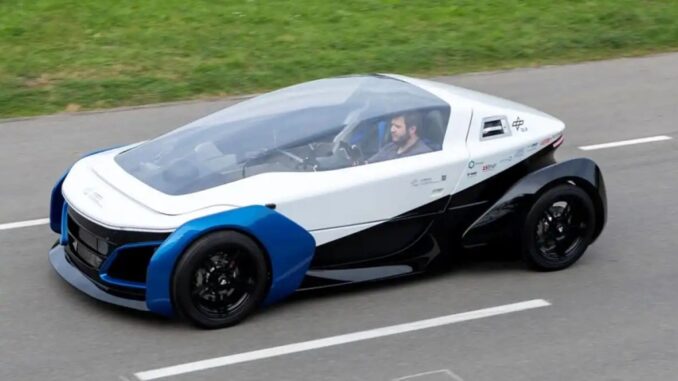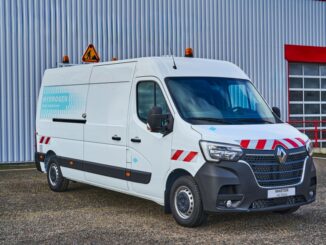
The SLRV (Safe Light Regional Vehicle) was developed by the German aerospace center (Deutsches Zentrum für Luft- und Raumfahrt, DLR).
The vehicle is part of the research project Next Generation Car (NGC) concerning the safety of today’s lightweight microcars with the novel metal sandwich construction. This together with an innovative entry concept, highly efficient H2 fuel cell drive system and crash-optimized chassis were able to achieve the ambitious targets regarding weight (450 kg), safety, energy consumption and manufacturing cost.
The body of the two-seat SLRV is 3.8 meters long and low to the ground, for the lowest possible air resistance. The additionally low weight is crucial for low energy consumption. Even for electrified vehicles with recuperation, up to 93 percent of energy consumption, depending on which point in the drive cycle, is weight-dependent [FRI2010]. A low body mass also enables secondary mass reduction, so smaller and more cost-effective drive components, and its effects.
How
According to initial simulation results, the SLRV is expected to consume only half as much hydrogen as a conventional fuel cell-powered passenger car.
Sandwich construction: light, low-cost, safe
To achieve the goal of a lightweight and safe construction that is nevertheless cost-effective, the so-called metal sandwich construction (metallische Sandwichbauweise) was developed (see Fig. 2). The materials are composed of metal cover layers and plastic foam as the core. The front and rear sections of the SLRV are composed of sandwich panels and serve as crumple zones. A large part of the vehicle’s machinery is also housed there.
The passenger compartment consists of a floor tray braced by a ring structure. This absorbs the forces that act on the car while it’s driving and protects the occupants in the event of a crash. With the floor tray, assemblies that are individually found in the passenger compartment of a conventional car body, such as front wall, rear wall, rocker panels and floor, are combined into a single construction element, which significantly reduces the complexity as well as the number of joints.
Similar advantages are offered by the use of the upward-opening canopy in conjunction with a roll bar. With these, the doors, posts, A and C pillars, and roof have been replaced by a single piece. So far, structures made of sandwich materials have not yet been used in the series production of vehicles. The DLR has shown its potential and in the next step is working to optimize the relevant manufacturing technologies.
Crash behavior in the event of a frontal impact
The crash behavior of the SLRV body during a frontal impact was analyzed and documented in accordance with US NCAP guidelines. Such a crash corresponds to an impact of the vehicle against a rigid wall at 56 km per hour (35 mph). The crash box and front end of the SLRV are evenly deformed in the process and absorb the crash energy. The passenger compartment is not deformed, to not reduce the survival space for the occupants.
Important for the crash behavior is also the chassis design of the SLRV. The chassis is designed in such a way that the wheels detach in the event of a crash and are guided past the car body. This way, the passenger compartment is not hit by the wheel and can be more simply designed.
Zero-emission: Fuel cell-battery hybrid
To be on the move in the least resource-demanding way possible, the SLRV possesses, in addition to the very light body, a highly efficient hybrid drivetrain. The SLRV’s drivetrain contains a small fuel cell with 8.5 kilowatt continuous output and a battery that delivers an additional 25 kilowatts for acceleration and can also recuperate energy through regenerative breaking. This combination weighs less than conventional battery systems, provides a range of around 400 kilometers (250 miles) and allows a top speed of 120 kilometers (75 miles) per hour. Also on board between the two seats is a 39-liter pressure tank capable of storing 1.6 kilograms of hydrogen at 700 bar.
Use examples and further development
The occupancy of passenger cars in German road traffic lies on average at 1.46 persons. The SLRV was therefore purposefully designed to be a light two-seater that, due to its low energy consumption and fuel cell system, nevertheless offers a comparatively long range. Consequently, the SLRV is suitable, for example, as a commuter car, shuttle to local public transport, car-sharing vehicle or company car – particularly in outer city or suburban areas. It could be a supplement to public transportation in the suburbs or the countryside, can be used as a second car and is well suited for car-sharing services due to the fast refueling with hydrogen.
Regarding the purchase price, the SLRV team at this time is assuming it will be about 15,000 euros. With an expected service life of ten years and a mileage of 300,000 kilometers (190,000 miles), that works out to about ten cents per kilometer.
Talks are currently being held with companies with the aim of further developing the SLRV into a vehicle for series production. In addition, a memorandum of understanding has already been signed with the hydrogen fueling company Blu Power.
By Michael Kriescher, DLR-Institut für Fahrzeugkonzepte, Stuttgart, Germany
Source: H2 International




Be the first to comment